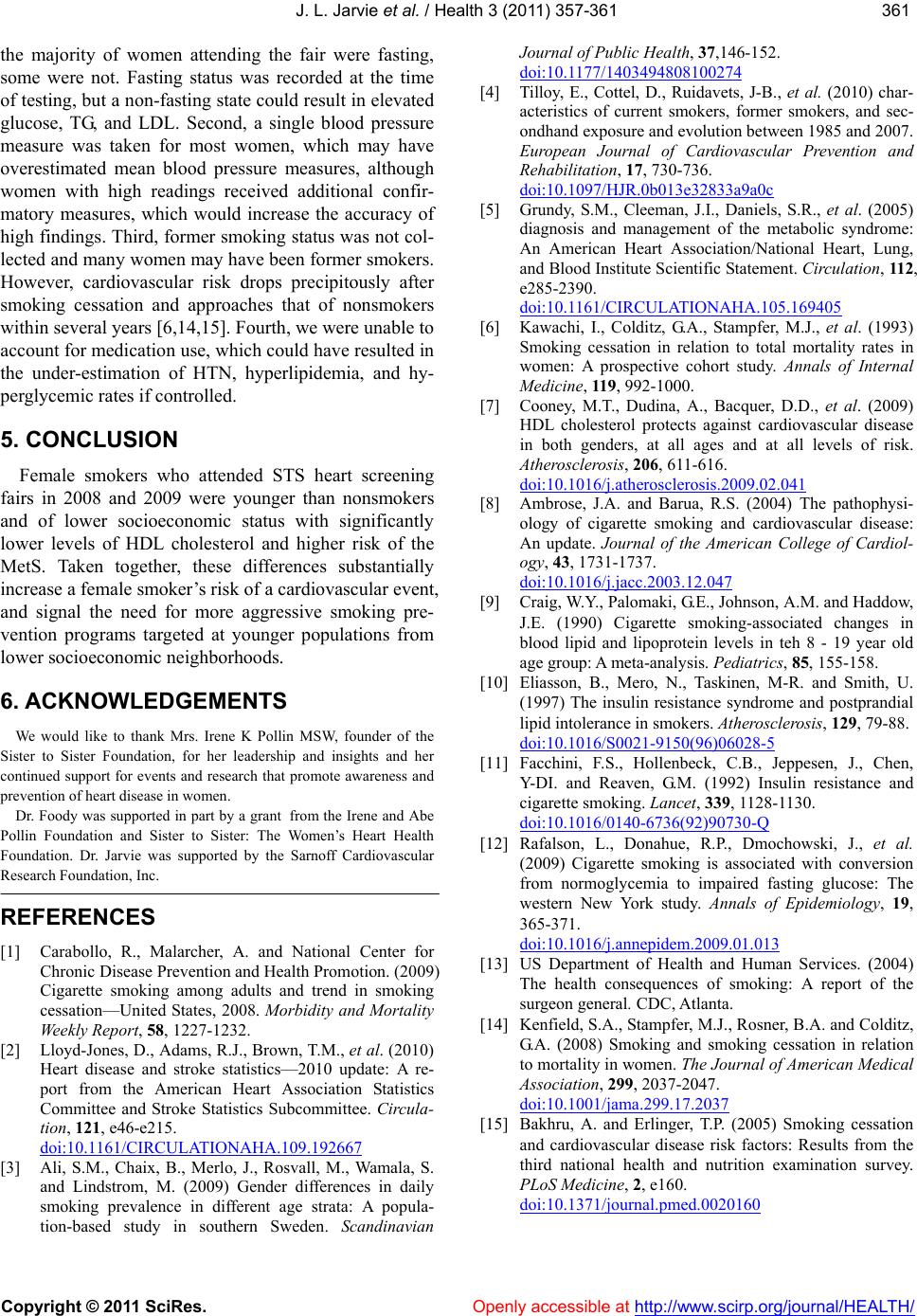
J. L. Jarvie et al. / Health 3 (2011) 357-361
Copyright © 2011 SciRes. Openly accessible at http://www.scirp.org/journal/HEALTH/
361361
the majority of women attending the fair were fasting,
some were not. Fasting status was recorded at the time
of testing, but a non-fasting state could result in elevated
glucose, TG, and LDL. Second, a single blood pressure
measure was taken for most women, which may have
overestimated mean blood pressure measures, although
women with high readings received additional confir-
matory measures, which would increase the accuracy of
high findings. Third, former smoking status was not col-
lected and many women may have been former smokers.
However, cardiovascular risk drops precipitously after
smoking cessation and approaches that of nonsmokers
within several years [6,14,15]. Fourth, we were unable to
account for medication use, which could have resulted in
the under-estimation of HTN, hyperlipidemia, and hy-
perglycemic rates if controlled.
5. CONCLUSION
Female smokers who attended STS heart screening
fairs in 2008 and 2009 were younger than nonsmokers
and of lower socioeconomic status with significantly
lower levels of HDL cholesterol and higher risk of the
MetS. Taken together, these differences substantially
increase a female smoker’s risk of a cardiovascular event,
and signal the need for more aggressive smoking pre-
vention programs targeted at younger populations from
lower socioeconomic neighborhoods.
6. ACKNOWLEDGEMENTS
We would like to thank Mrs. Irene K Pollin MSW, founder of the
Sister to Sister Foundation, for her leadership and insights and her
continued support for events and research that promote awareness and
prevention of heart disease in women.
Dr. Foody was supported in part by a grant from the Irene and Abe
Pollin Foundation and Sister to Sister: The Women’s Heart Health
Foundation. Dr. Jarvie was supported by the Sarnoff Cardiovascular
Research Foundation, Inc.
REFERENCES
[1] Carabollo, R., Malarcher, A. and National Center for
Chronic Disease Prevention and Health Promotion. (2009)
Cigarette smoking among adults and trend in smoking
cessation—United States, 2008. Morbidity and Mortality
Weekly Report , 58, 1227-1232.
[2] Lloyd-Jones, D., Adams, R.J., Brown, T.M., et al. (2010)
Heart disease and stroke statistics—2010 update: A re-
port from the American Heart Association Statistics
Committee and Stroke Statistics Subcommittee. Circula-
tion, 121, e46-e215.
doi:10.1161/CIRCULATIONAHA.109.192667
[3] Ali, S.M., Chaix, B., Merlo, J., Rosvall, M., Wamala, S.
and Lindstrom, M. (2009) Gender differences in daily
smoking prevalence in different age strata: A popula-
tion-based study in southern Sweden. Scandinavian
Journal of Public Health, 37,146-152.
doi:10.1177/1403494808100274
[4] Tilloy, E., Cottel, D., Ruidavets, J-B., et al. (2010) char-
acteristics of current smokers, former smokers, and sec-
ondhand exposure and evolution between 1985 and 2007.
European Journal of Cardiovascular Prevention and
Rehabilitation, 17, 730-736.
doi:10.1097/HJR.0b013e32833a9a0c
[5] Grundy, S.M., Cleeman, J.I., Daniels, S.R., et al. (2005)
diagnosis and management of the metabolic syndrome:
An American Heart Association/National Heart, Lung,
and Blood Institute Scientific Statement. Circulation, 112,
e285-2390.
doi:10.1161/CIRCULATIONAHA.105.169405
[6] Kawachi, I., Colditz, G.A., Stampfer, M.J., et al. (1993)
Smoking cessation in relation to total mortality rates in
women: A prospective cohort study. Annals of Internal
Medicine, 119, 992-1000.
[7] Cooney, M.T., Dudina, A., Bacquer, D.D., et al. (2009)
HDL cholesterol protects against cardiovascular disease
in both genders, at all ages and at all levels of risk.
Atherosclerosis, 206, 611-616.
doi:10.1016/j.atherosclerosis.2009.02.041
[8] Ambrose, J.A. and Barua, R.S. (2004) The pathophysi-
ology of cigarette smoking and cardiovascular disease:
An update. Journal of the American College of Cardiol-
ogy, 43, 1731-1737.
doi:10.1016/j.jacc.2003.12.047
[9] Craig, W.Y., Palomaki, G.E., Johnson, A.M. and Haddow,
J.E. (1990) Cigarette smoking-associated changes in
blood lipid and lipoprotein levels in teh 8 - 19 year old
age group: A meta-analysis. Pediatrics, 85, 155-158.
[10] Eliasson, B., Mero, N., Taskinen, M-R. and Smith, U.
(1997) The insulin resistance syndrome and postprandial
lipid intolerance in smokers. Atherosclerosis, 129, 79-88.
doi:10.1016/S0021-9150(96)06028-5
[11] Facchini, F.S., Hollenbeck, C.B., Jeppesen, J., Chen,
Y-DI. and Reaven, G.M. (1992) Insulin resistance and
cigarette smoking. Lancet, 339, 1128-1130.
doi:10.1016/0140-6736(92)90730-Q
[12] Rafalson, L., Donahue, R.P., Dmochowski, J., et al.
(2009) Cigarette smoking is associated with conversion
from normoglycemia to impaired fasting glucose: The
western New York study. Annals of Epidemiology, 19,
365-371.
doi:10.1016/j.annepidem.2009.01.013
[13] US Department of Health and Human Services. (2004)
The health consequences of smoking: A report of the
surgeon general. CDC, Atlanta.
[14] Kenfield, S.A., Stampfer, M.J., Rosner, B.A. and Colditz,
G.A. (2008) Smoking and smoking cessation in relation
to mortality in women. The Journal of American Medical
Association, 299, 2037-2047.
doi:10.1001/jama.299.17.2037
[15] Bakhru, A. and Erlinger, T.P. (2005) Smoking cessation
and cardiovascular disease risk factors: Results from the
third national health and nutrition examination survey.
PLoS Medicine, 2, e160.
doi:10.1371/journal.pmed.0020160